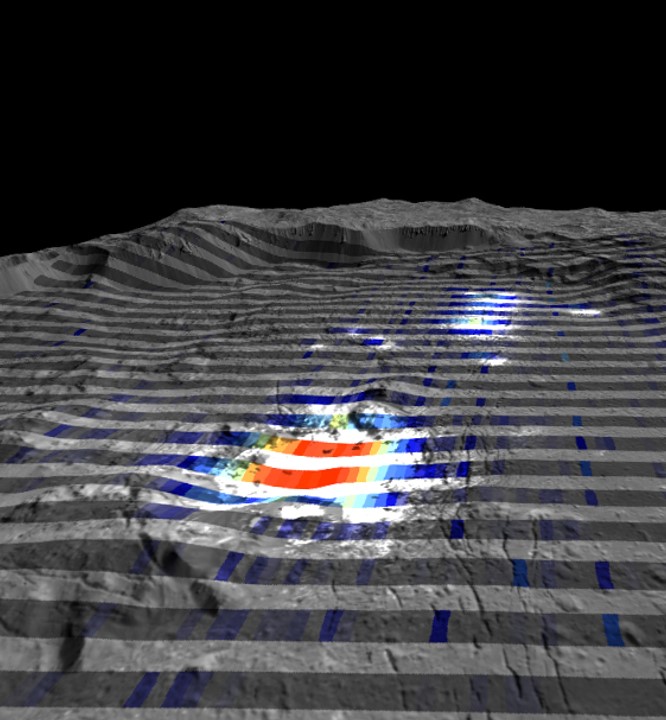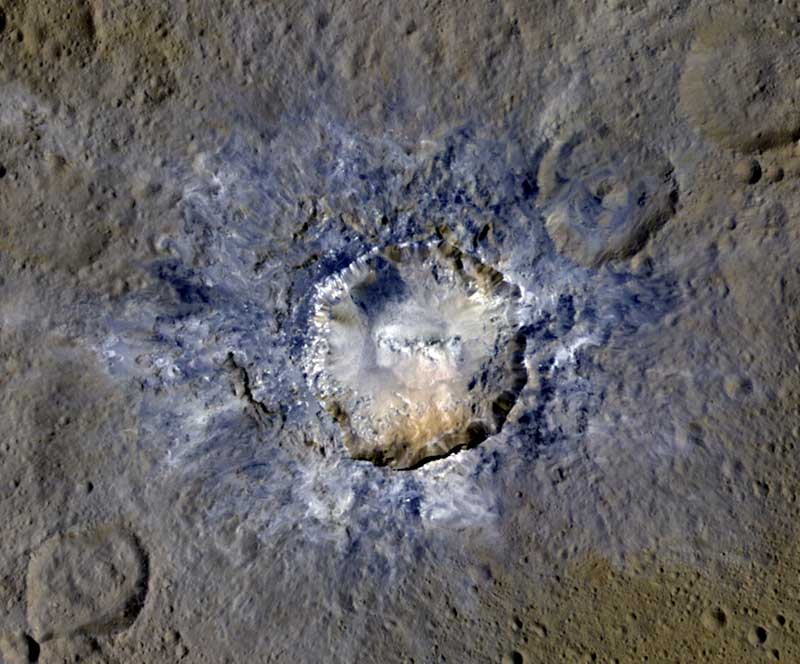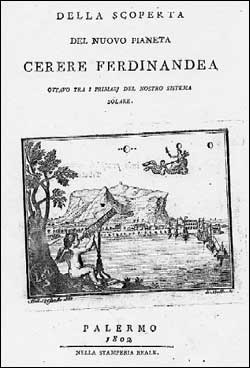Back
June 30, 2016
Ceres was discovered on 1 January 1801 by the Italian astronomer Giuseppe Piazzi. Piazzi named it Ceres Ferdinandea in honor of the Roman goddess Ceres and Ferdinand IV of Bourbon.
Ceres and the discovery Piazzi
| Already for nine years I travailing to verify the positions of the stars that are collected will ‘various catalogs of the astronomers, on the evening of January 1 of the current year, among many other sought I 87.a of the Catalogue of the zodiacal stars Abbot La Caille. I saw, therefore, that it was preceded by another, which according to custom, I wanted to still be observed, all the more so, that did not prevent the main observation. his light was a little weak, and the color of Jupiter, but similar to many others, which generally are placed eighth school compared to their size. I was born so no doubt about her nature. The evening of the two replied my observations, and having found that did not match neither the time nor the distance from the zenith, I doubted at first to some error the previous observation: I conceived following a slight suspicion that perhaps could be a new star. the three night my suspicion became a certainty, Having ensured that it was not a fixed star. Nothing less, come to talk about it waited on the evening of 4, when I had the satisfaction of seeing, which had moved with the same law that had held in the previous days … “ |
| ( from the diary of Giuseppe Piazzi ) |
Ceres is the largest object among those who inhabit the asteroid belt. The questions that scientists try to answer are related to the amount of water that mainly make and, if once the dwarf planet was habitable.
It was March 6, 2015, when the probe of the NASA Dawn entered the orbit of Ceres , the dwarf planet located between Mars and Jupiter. Since then the probe has collected a huge amount of images and data that allow us to know more about this planet until now unexplored.
MEDIA INAF / ASI – the brightest area of the dwarf planet Ceres, located inside the crater Occator, has the highest concentration of carbonates ever recorded in environments outside than the Earth. The type and abundance of these minerals suggests that there has been the presence of liquid water below the surface of Ceres in recent geological time.
The discovery was obtained from a team of researchers coordinated by researcher INAF Maria Cristina De Sanctis thanks to the Italian spectrometer observations VIR on board the mission Dawn NASA , provided by the Italian Space Agency (ASI) under the scientific guidance of the Institute of Astrophysics.

perspective view of the crater Occator of Ceres data acquired from VIR spectrometer with overlapping. In red areas with greater abundance of carbonates, in gray those with lower concentrations. Credit: INAF / ASI / NASA / DLR / MPS. Images created by A.Frigeri-IAPS-INAF
Our insights Ceres
liquid water in the past of Ceres?
” this is the first time we see a number so high of this material in other parts of the solar System , “says Maria Cristina De Sanctis, principal investigator VIR and first author of the paper describing the discovery, published in the latest issue of the magazine Nature .
Occator is a young crater from a geological point of view, which was formed about 80 million years ago. With a width of 92 kilometers and a central depression of about 10 kilometers in diameter, the crater in the central area shows a broad peak covered with highly reflective material with both radial and concentric fractures above and around it.
the De Sanctis team found that the most abundant mineral in this area is very bright sodium carbonate, a salt that on Earth is typical of hydrothermal environments. This material would be leaked from inside of Ceres, because it may not have been deposited by the impact of an asteroid.
So the ascent of this material from the deeper layers of the celestial body suggests that temperatures in Ceres are higher than previously thought so far.
it could probably have been an impact with the asteroid that formed the crater Occator to favor the exposure on the surface carbonate observed today, but the researchers think a role in this emergence they have also had internal processes to Ceres itself.
on the long journey of Dawn Italy he has participated in the forefront, with the spectrometer image VIR-MS ( Visible and Infrared Mapping spectrometer ) provided by ASI and developed by Finmeccanica- Selex ES under the scientific guidance of ‘ INAF-IAPS . “VIR is a tool that operates in the visible and infrared, for which Italy has a scientific and industrial leadership internationally recognized.
This type of instrument has been successfully deployed on other missions of exploration of the solar system including Cassini, Rosetta and Venus Express and provided basic data for the study of observed celestial bodies and for understanding their origin. ” [ Barbara Negri - Head of the Italian Space Agency Universe Observation]
The survey results the hypothesis that under the surface of Ceres may have existed liquid water in recent geological epochs. The salts may be the remains of an ancient ocean, or water accumulation climbed back to the surface and then solidified millions of years ago.
surveys on Water and discoveries of Ceres
“ the minerals that we have identified in the bright central region of the crater Occator must necessarily have been formed by the interaction with water “, adds De Sanctis. “ The presence of carbonates reinforces the idea that Ceres had internal hydrothermal activity, which pushed these materials to the surface, within Occator .
last year, in another work always presented on Nature , the De Sanctis led team found that the surface of Ceres contains clays containing ammonia. As ammonia is a substance rather abundant in the outer solar system, this result suggested the idea that Ceres may have formed in the vicinity of the orbit of Neptune and later migrated to the inner areas of our planetary system.
another scenario suggests that the celestial body was formed in the area where he is today, but with material from the outer solar system.
the new surveys conducted within the Occator crater indicate the presence in those regions also ammonia salts in the form of ammonium chloride and bicarbonate ammonium. The discovery of compounds latter further strengthens the link between Ceres and the icy worlds of the solar system to present boundaries.

the ammonia, along with sodium carbonate and sodium bicarbonate is also in fact been found in plumes that stand out from Enceladus, one of Saturn’s icy moon known for its geysers that erupt from cracks in its surface.
“ The next step will also study other bright spots on the surface of Ceres, to see if they also contain these carbonates ” concludes De Sanctis.
Ceres
“ to underline the importance of the Italian Space Agency’s role ” – highlights Raffaele Mugnuolo , responsible for program to participation in the Dawn mission – “ in ensuring the Italian participation in the mission through an agreement with NASA and DLR, and then for the realization of the VIS-MS instrument, and full support to the Italian scientific team that put under the right conditions, can achieve excellent results like this .
on the water study of Ceres team
in the team that conducted the study, published online on the website of the journal Nature article Bright carbonate deposits as evidence of aqueous alteration on (1) Ceres was attended, in addition to Maria Cristina De Sanctis, also researchers INAF Andrea Raponi, Eleonora Ammannito (University of California Los Angeles and associated INAF), Mauro Ciarniello, Filippo Giacomo Carrozzo, Federico Tosi, Francesca Zambon, Fabrizio Capaccioni, Maria Theresa Capria, Sergio source, Michelangelo Formisano, Alessandro Frigeri, Marco Garden, Andrea Lombard, Gianfranco Magni, Ernesto Palomba, Simone Marchi (Southwest Research Institute and associated INAF) and Raffaele Mugnuolo (Italian Space Agency)

No comments:
Post a Comment